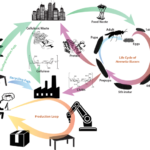Circular manufacturing of chitinous bio-composites via bioconversion of urban refuse
Bioinspired manufacturing, in the sense of replicating the way nature fabricates, may hold great potential for supporting a socioeconomic transformation towards a sustainable society. Use of unmodified ubiquitous biological components suggests for a fundamentally sustainable manufacturing paradigm where materials are produced, transformed into products and degraded in closed regional systems with limited requirements for transport. However, adoption is currently limited by the fact that despite their ubiquitous nature, these biopolymers are predominantly harvested as industrial and agricultural products. In this study, we overcome this limitation by developing a link between bioinspired manufacturing and urban waste bioconversion. This result is paramount for the development of circular economic models, effectively connecting the organic by-products of civilization to locally decentralized, general-purpose manufacturing.
Learn about our two Decals!
 Click here to find out more about our Fall Bioinspired Design Decal and our Spring Bioinspired Design in Action Decal – ALL MAJORS are welcome.
Click here to find out more about our Fall Bioinspired Design Decal and our Spring Bioinspired Design in Action Decal – ALL MAJORS are welcome.Berkeley BioDesign Community
 Click here to learn about the BioD: Bio-Inspired Design @ Berkeley student organization or here to signup for more info.
Click here to learn about the BioD: Bio-Inspired Design @ Berkeley student organization or here to signup for more info.Search
Student Login




I imagine that the neurological circuits underlying these processes are governed by both 2d spacing maps with their brains as…
to reduce the impact of car accidents, it may be possible to study the force diverting physics of cockroaches to…
you see this type of head-bobbing stability in many avian creatures related to pigeons like chickens. the head ability to…
not like they taught horses how to run! this is an example of convergent evolution where both sea creatures and…
The brain functions in a similar way with neuronal connections. our brains are able to utilize the multiplicity of connections…